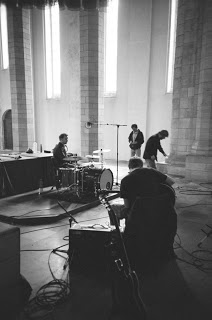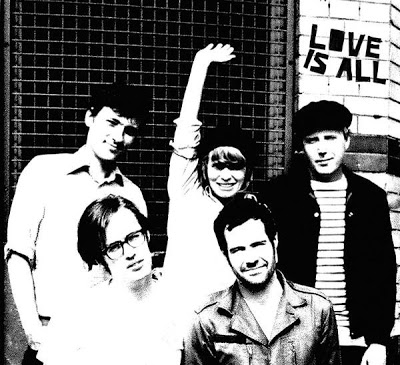In an effort to post about all things music related here is a re-post of an interesting article I found on-line about the darker side of sound - how humanity has come to use it as a form of "no- touch toture".
I wasn't feeling into posting a metal logo today - sorry.
Music as torture / Music as weapon
(notes and references can be found by hitting the link)
By Suzanne G. Cusick; a professor of musicology at New York University
AbstractOne of the most startling aspects of musical culture in the post-Cold War United States is the systematic use of music as a weapon of war. First coming to mainstream attention in 1989, when US troops blared loud music in an effort to induce Panamanian president Manuel Norriega’s surrender, the use of “acoustic bombardment” has become standard practice on the battlefields of Iraq, and specifically musical bombardment has joined sensory deprivation and sexual humiliation as among the non-lethal means by which prisoners from Abu Ghraib to Guantanamo may be coerced to yield their secrets without violating US law.
The very idea that music could be an instrument of torture confronts us with a novel—and disturbing—perspective on contemporary musicality in the United States. What is it that we in the United States might know about ourselves by contemplating this perspective? What does our government’s use of music in the “war on terror” tell us (and our antagonists) about ourselves?
This paper is a first attempt to understand the military and cultural logics on which the contemporary use of music as a weapon in torture and war is based. After briefly tracing the development of acoustic weapons in the late 20th century, and their deployment at the second battle of Falluja in November, 2004, I summarize what can be known about the theory and practice of using music to torture detainees in Afghanistan, Iraq and Guantanamo. I contemplated some aspects of late 20th-century musical culture in the civilian US that resonate with the US security community’s conception of music as a weapon, and survey the way musical torture is discussed in the virtual world known as the blogosphere. Finally, I sketch some questions for further research and analysis.
Exordium
This paper reports on the earliest stages of a project that began not in my musicological work but in a moment of my real life. In spring, 2003, I was reading Nuha al-Radi’s Baghdad Diaries, an account of her life before, during and after the first Gulf War. I read
After the war ended, the Allies spent all day and all night flying over our heads, breaking the sound barrier. Just like Panama when they blasted Noriega, holed up in the Vatican Embassy with music. For fifteen days, Bush deafened the poor ambassador and Noriega with hard rock. Our torture went on for months-- 20 or 30 times, day or night... (al-Radi 1998: 58)
“So,” I thought, “perhaps it wasn’t just silliness, the actions of bored or excitable soldiers who’d seen Apocalypse Now too many times. Perhaps it was a policy.” As press reports conflating music’s use on the battlefield with its use in interrogations proliferated, I began desultory research on a phenomenon of the current “global war on terror” that particularly wounds me as a musician–wounds me in that part of my sensibility that remains residually invested in the notion that music is beautiful, even transcendent–is a practice whose contemplation would always lead me to contemplation of bodies and pleasures. Not bodies in pain.
It is not my intention here to engage the moral, ethical and political debates around torture, interesting as they are. Rather, I offer today a rough taxonomy of the complex subject denoted by my title--the US government’s use of sound and music as a battlefield weapon and its use of music during the interrogation of “detainees” in the current GWOT. It is a taxonomy peppered with questions and speculations about the ways that these uses of music interact with more familiar aspects of recent musical culture in the United States.
Music (or sound) as a weapon
“Acoustic weapons” have been in development by Department of Defense contractors since at least the 1997 creation of the Joint Non-Lethal Weapons Task Force, accounting for 1/3 of the Task Force’s budget in 1998-99. Thus, they are not peculiar to 21st-century wars, or to the current administration. The earliest contract I know to have been let for such a weapon was on November 18, 1998, authorizing now-defunct Synetics Corporation to produce a tightly focused beam of infrasound–that is, vibration waves slower than 100 vps–meant to produce effects that range from “disabling or lethal”. In 1999, Maxwell Technologies patented a HyperSonic Sound System, another “highly directional device ... designed to control hostile crowds or disable hostage takers”. The same year Primex Physics International patented both the “Acoustic Blaster”, which produced “repetitive impulse waveforms” of 165dB, directable at a distance of 50 feet, for “antipersonnel applications”, and the Sequential Arc Discharge Acoustic Generator, which produces “high intensity impulsive sound waves by purely electrical means”.
As far as I know, none of these have been deployed in the current wars. They have been supplanted in the non-lethal weapons arms race by a system the American Technology Corporation developed after 2000 –the Long Range Acoustic Device, or LRAD. Capable of projecting a “strip of sound” (15 to 30 inches wide) at an average of 120 dB (maxing at 151 dB) that will be intelligible for 500 to 1,000 meters (depending on which model you buy), the LRAD is designed to hail ships, issue battlefield or crowd-control commands, or direct an “attention-getting and highly irritating deterrent tone for behavior modification”. (http://www.atcsd.com) As of March, 2006, 350 LRAD systems had been sold–to the US Navy, the Coast Guard, various commercial shippers for marine interdiction; to the US Army and Marines for use by PsyOps units, and at checkpoints and internment facilities; to the police departments of Boston, New York, Los Angeles, Santa Ana, and Broward County, Florida. According to the US Army’s 361st PsyOps company, LRAD’s are used
for clearing streets and rooftops during cordon and search, for disseminating information, and for drawing out enemy snipers who are subsequently destroyed by our own snipers (Davison and Lewer 2006).
It can also be set to “fire” short bursts of “intense acoustic energy” into crowds, to incapacitate people by causing spatial disorientation. Similar weapons deployed by Israel in Gaza and Lebanon produce the effect of “being hit by a wall of air that is painful on the ears, sometimes causing nosebleeds and leaving you shaking inside”.(Davison and Lewer 2006).
Capable of directing “music through the use of an integrated and hardened MP3 player”, and of accepting “external audio devices, like a CD or MP3 player”, LRADs have been deployed with combat units since the fall of 2003. According to an ATC spokesman, they were used in Iraq in 2004 “to play both high output music and deterrent tones, evidently to great effect as a PsyOps tool, causing the insurgents to react in ways that greatly increased their vulnerability”. Most likely, LRADs were the means by which the 361st PsyOps company “prepared the battlefield” for the November 2004 siege of Fallujah by bombarding the city with music–supposedly, with Metallica’s “Hells’ Bells” and “Shoot to Thrill” among other things (DeGregory 2004). PsyOps spokesman Ben Abel explained to reporter Lane DeGregory of the St. Petersburg (Florida) Times, “These harassment missions work especially well in urban settings like Fallujah. The sounds just keep reverberating off the walls.” Abel added “it’s not the music so much as the sound. It’s like throwing a smoke bomb. The aim is to disorient and confuse the enemy to gain a tactical advantage” (DeGregory 2004). Abel made clear that although the tactic of bombarding the enemy with sound was made at the command level, the choice of music was left to soldiers in the field: “...our guys have been getting really creative in finding sounds they think would make the enemy upset...These guys have their own mini-disc players, with their own music, plus hundreds of downloaded sounds. It’s kind of personal preference how they choose the songs. We’ve got very young guys making these decisions” (DeGregory 2004). On the battlefield, then, the use of music as a weapon is perceived to be incidental to the use of sound’s ability to affect a person’s spatial orientation, sense of balance, and physical coordination. It is because music is incidental that the choice of repertoire is delegated to individual PsyOps soldiers’ creativity.
Music as torture.
Although it seems to be both more widespread and older, the calculated use of music in “detainee interrogations” is less easy to trace than the use of sound as a weapon. Evidence from the current war is spotty, based on the debriefings of released detainees by international human rights organizations and reporters, on the accounts currently detained persons have given to their lawyers, or on urban legends that circulate on the internet, some of which are corroborated by the other two kinds of accounts. Still, it is absolutely clear that music plays an important role in the interrogation of detainees in the war on terror. As early as May 2003 the BBC reported that the US Army had used Metallica’s “Enter Sandman” and Barney the Purple Dinosaur’s “I Love You” in the interrogation of Iraqi detainees, playing the songs repeatedly at high volume inside of shipping containers. Documents obtained by the ACLU include an email from an unidentified FBI agent, dated Dec. 5, 2003, that describes at least three incidents involving Guantanamo detainees being chained to the floor and subjected to “extreme heat, extreme cold, or extremely loud rap music”. . The June 12, 2005 issue of Time included a story based on the 84-page log of Mohammed al Qahtani’s interrogation there from November 2002 to January 2003 (Zagorin and Duffy 2005). Qahtani’s interrogations began at midnight; whenever he dozed he was awakened either by water poured over his head or the sound of Christina Aguilera’s music. In December 2005, Human Rights Watch posted brief first-person accounts of detainees released from a secret prison in Afghanistan, many of whom asserted that part of their experience included being held in a pitch-black space and forced to listen to music that they described, variously, as “unbearably loud”, “infidel”, or “Western”. The same posting included the account of Guantanamo prisoner Benyan Mohammed, an Ethiopian who had lived in Britain, and who had been forced to listen to music by Eminem (Slim Shady) and Dr Dre for twenty days before the music was replaced by “horrible ghost laughter and Halloween sounds.” A long New York Times story on March 19, 2006, described in detail “Camp Nama”, the headquarters of a multiple-agency interrogation unit at Baghdad International Airport; there, “high-value detainees”–those believed to have information directly pertinent to battlefield movements, terrorist ringleaders, or imminent terrorist attacks--were sent first to the so-called “Black Room”, a garage-sized, windowless space painted black where “rap music or rock’n’roll blared at deafening decibels over a loudspeaker” (Schmitt and Marshall 2006). Read together, these reports suggest that the “deafening music” is usually delivered to a detainee who has been chained into a “stress position”, in a pitch-black space made uncomfortably hot or cold.
“No-touch torture”
It would be possible to assume from the evidence in the popular press that the use of music in “interrogation” is (as one of the sources for the 2003 BBC story, claimed) “rather new”. I’m sorry to report that my reading suggests otherwise; nor is it the random, rogue behavior of particularly sadistic (or musical, or creative) interrogators and MPs. Rather, it is one component of a standard set of interrogation practices developed by the CIA (in cooperation with English and Canadian intelligence agencies) over the second half of the 20th century–a standard set of practices that includes the hooding, stress positions, and sexual/cultural humiliation that the photos leaked from Abu Ghraib prison enabled us to see. Its advocates call this set of practices “no touch torture”.
In his 2006 book A Question of Torture, historian Alfred W McCoy traces the origin of “no touch torture” to a research program funded by the OSS, the CIA, and the intelligence services of Canada and Britain in the years after World War II. Concerned by Soviet success at “brainwashing” captives and destroying their wills, these agencies supported research at Yale, Cornell, and McGill intended to learn how we might do the same. In the 1950s this contract research was concentrated in three areas: 1) the Canadian government funded research at McGill that explored the devastating impact of sensory deprivation and sensory manipulation–which would eventually include hooding; continuous noise (whether loud or not) and its opposite, soundproofing; temporal disorientation, and erratic provision of food and drink; 2) the CIA funded research at Cornell and Yale on the effects of self-inflicted pain–which would eventually include stress positions, and scenarios that provoked personal, sexual or cultural humiliation; and 3) the CIA funded research at Yale on the capacity of ordinary people to inflict lethal pain on others.
The reports of these experiments reveal a universalizing naivete and cultural bias that seems laughable now. Yet their results are the core premises of what the European Human Rights Commission described in 1976 as a “modern system of torture” (McCoy 2006: 57). This modern system aims to combine “sensory disorientation”–isolation, standing, extremes of heat and cold, light and dark, noise and silence–with self-inflicted pain, both physical and psychological, so as to cause a prisoner’s very “identity to disintegrate”. Whether that disintegration takes the form of induced regression (to infantile behavior) or induced schizophrenia, “the effect is much like that which occurs if he is beaten, starved or deprived of sleep”. The prisoner becomes psychologically powerless before the authority of interrogators, both dependent and unable to resist. Moreover, the experimental data showed this “modern system of torture” to be much more efficient than beatings or starvation, producing psychological disintegration in a matter of days, rather than weeks or months. And, as one CIA researcher noted, it was hard to document, for with the exception of the standing (which can cause grotesque swelling/bruising of the feet and legs) these “techniques” leave no visible marks on the fleshy surfaces of a human body.
Institutionalized in 1963 in the CIA’s Kubark Counterintelligence Interrogation Handbook, the techniques of “no-touch torture” were used–indeed, consciously tested again and again--by the CIA’s counter-insurgency forces in Vietnam into the 1970s, by the English in Northern Ireland, and by police units from Uruguay, Brazil, Guatemala, the Phillipines, Iran, Argentina and Chile who were trained at the US Office of Public Safety (1962-74), the US Army Intelligence Center in Fort Huachuca, AZ, or the US Army School of the Americas (based in Panama until 1976, and now based at Fort Benning, Georgia). Although the CIA’s interrogation techniques are not mentioned in either the 1992 or September 2006 editions of the US Army’s Field Manual for Human Intelligence Collection (HUMINT), the principal textbook for training at Fort Huachuca, they seem to be part of Army interrogators’ and PsyOps units’ training there. (The music most often mentioned in accounts of this training is the song “I love you” associated with Barney the purple dinosaur.) In the field manuals, the elements of “no touch torture” are understood to be subsumed under the heading of “additional psychological strategies” by which interrogators are encouraged to implement any of the eighteen declassified “approaches” to an informant–approaches with headings like “fear up” and “ego down”. If one reads the press and human rights organization accounts of “no touch torture” carefully, these incidents can all be traced not to uniformed servicemen, but to occasions when multiple-agency teams –that is, teams that include CIA operatives, and Behavioral Science Consultants--administer the interrogations. In part because CIA operatives are specifically exempt from the provisions of the Military Commissions Act of 2006, in part because the elements of “no touch torture” are part of what one might call the military’s oral tradition, all the elements of “no-touch torture” except waterboarding and extremes of hot and cold remain permissible under the recently-signed Military Commissions Act of 2006–permissible, and, to protect against international prosecution as violations of the UN Convention on Torture, retroactively pardoned.
Cultural resonances
“No-touch torture” shares with non-lethal weapons the advantage that it leaves no marks directly caused by interrogators on the visible, fleshy surfaces of the body. Thus hard to prove, and hard to jibe with images of torture familiar from visual and literary culture, “no-touch torture’s” premise is nonetheless consistent with the premise behind non-lethal weapons, including those that use sound; and it is consistent with the premise by which PsyOps units use sound or music to prepare the battlefield. The common premise is that sound can damage human beings, usually without killing us, in a wide variety of ways. What differentiates the uses of sound or music on the battlefield and the uses of sound or music in the interrogation room is the claimed site of the damage. Theorists of battlefield use emphasize sound’s bodily effects, while theorists of the interrogation room focus on the capacity of sound and music to destroy subjectivity. There’s something here about the intersection of mind/body relationship with the distinction between private and public space, and the hierarchy of command and field operations, that I want eventually to think more about.
I also want to think much more about the eerie resonances between the aesthetics implied by theorists of “no-touch torture” and the aesthetics shared by a wide range of music cultures since the 1960s–the music cultures that formed my sensibility, and, arguably, the sensibilities of those who designed, who command and who implement the acoustic aspects of “no-touch torture” and acoustic battle. I find two especially intriguing. First, both blur the distinction between sound and music. But whereas many composers, musicians and scholars have tended to conceive that blurring as producing an acoustic continuum, the state’s actors seem very clear that “music”, with all its cultural specificity, is less important than the power of sound itself. How, I wonder, might one interpret the resulting state-imposed hierarchy of sound over music? Specifically, how might inscribing such a hierarchy serve the state’s interests away from battlefield and interrogation sites? Second, the state’s interrogators share with many civilian musicians, composers and scholars the notion that listening to music can dissolve subjectivity, releasing a person into a paradoxical condition that is both highly embodied and almost disembodied in the intensity with which one forgets important elements of one’s identity, and loses track of time’s passing. The practices and ideologies of classical music listening suggest that such music-induced ecstasy is produced by intense attention to the relationships among the sounds themselves. Such listening, Fred Maus has recently written, “seeks identification with the controlling persona”. Maus goes on to quote Edward T Cone “The goal ... must be identification with the complete musical persona by making its utterance one’s own” (Maus 2004: 36).
Could this notion of listening, propagated in elite universities (including those on contract to the CIA) in the last half of the 20th century, have influenced the architects of “no touch torture”? Is it, in itself, another symptom of the national security state that the US has been since the era of World War II? How might that notion of listening, which relies on its denial of both purely acoustic phenomena and non-acoustic psycho-somatic experiences in the moment of listening, have interacted, in those years, with the notion that theorists of “no touch torture” share with many vernacular proponents of psychedelic rock-- the belief that music dissolves subjectivity in conjunction with other psycho-somatic experiences, and always operates partly through its bodily effects? How, if at all, might the two different notions of how music ruptures subjectivity complement the distinctions drawn by the state between “sound” and “music”, “command” and “field execution”, “weapon” and “interrogation”? How might our own musical behaviors–as scholars and teachers especially–interact with these distinctions?
Music, torture and the blogosphere(or, Is it torture, and what’s the playlist?)
Nearly every story in the mainstream US press about music’s use to “torture” detainees has prompted responses in the virtual world known as the blogosphere. I discovered these responses by accident, but quickly realized that they were at least as important to understanding the relationship of “music as torture” to civilian musical culture as thinking about classical music listening practices. In a way, I have thought, the blogosphere responses document an important aspect of the current wars’ home front.
Most blog responses consist of the posted news story, followed by a handful of desultory comments. Some, however, consist of conversations that last from an hour or two (at lunchtime or in early evening) to several days. These longer conversations take one of two turns. Blogging communities who accept without question the idea that music is being used to torture detainees move quickly to political discussions of torture tout court, as it has been defined by recent US policy and law, and by recent international law. Generally, these conversations never return to music. But the other turn, taken by blogging communities who pose the question “But is it torture?”, often stays focused on music for quite a long time, regardless of how the question has been answered.
“Equating a cold room or loud music with torture is the worst kind of moral relativism”, wrote MayBee this past September 29 at
http://justoneminute.typepad.com,/ Soylent Red replied immediately “Careful, MayBee. We don’t want anyone to cry or suffer from lowered self esteem”. The exchange inspired an hour’s spirited competition among several bloggers about how best to torture detainees, all spinning off from Soylent Red’s second posting:
But perhaps we could make some lemonade of this. Openly admit gays to the military, but only as MPs or HUMINT collectors. Turn Guantanmo into a year-round Pride Parade. Everything these people eat, sleep on, what have you will have been touched by homosexuals. Every time they take a shower they are being watched by homosexuals. Reinstitute periodic strip searches. And every interrogation begins with the words “You know, I’ve been checking you out”.
By the end of the hour, MayBee had brought the thread back to music, posting about the Red Hot Chili Pepper’s song What I got I got to get it put in you... “Particularly if played in a camp run entirely by homosexuals with an enormous sign over the gate saying ‘The Gayest Place on Earth’, I’d break before lunch.” The same weekend, on the website
http://volokh.com/ Charlie (Colorado) mocked as an “absurdity” the idea that “loud music and sexually suggestive gestures from attractive women could become ‘torture’, when people not under interrogation pay substantial cover charges and tip heavily for the same experience”. Strategichamlet (mail) replied
I agree ... Anyone who has talked with a professional dominatrix knows that there are a great deal of people in this country who are willing to pay to be rather brutally tortured.
Both these exchanges startle for the casualness with which they confirm an aspect of contemporary musical life that some of us worked hard to articulate in the 1990s–the easy slippage, in the minds of our contemporaries, between music and sexuality. The first exchange implies that “torture” by music could be similar to a “torture” that induced homophobia, while the second likens “torture” by music to the “torture” of desirable heterosexual fantasy play for which US men would willingly pay.
Blogs whose communities assume that music could be torture extrapolate at first from their own experience of being forced to listen to music in genres, and from cultural locations, that they find distasteful. Overwhelmingly, the conversations open with an exchange like this one, from Dec 19 2005. Writing in response to Human Rights Watch’s press release about the Ethiopian forced to listen to rap for 20 hours, laz wrote to The J-Walk Blog (
https://mail.nyu.edu/attach/(http:/j-walkblog.com), “I used to have downstairs neighbors that would listen to rap. And let me assure you, it definitely has value as a torture device”. Leonardo replied “Twenty days? I go nuts after three minutes!,” while Keith Povell commented “Music as torture. Try listening to any commercial radio station (UK especially) and you’ll get the idea.” Many other bloggers understood music as torturous through memories of their own youths, or recent experiences with their adolescent children. At
http://forums.military.com/eve/forums/a/tpc/f/4091 a blog site for uniformed service people, peter3_1 commented on Sept 12, 2006 “Eminem’s Slim Shady is enough to drive a Moslem to drink! But, then, Iron Butterfly did that to my parents, not to mention the Doors, pure torture they thought. “Oh sure! Real torture! Heavy rock turned up and the a/c cranked real low. That sound’s like my daughter’s room!”, SGTBH wrote , adding later “Play Village People. You can stay at the YMCA over and over again. Play Queen.” Honoloulu 58 cautioned those who suggested classical music or show tunes “Got to watch [them], they can have a calming effect and/or euphoric feeling for some.”
Bloggers who accept the premise that music could be torture participate eagerly–indeed, almost gleefully–in virtual conversations aimed at producing the ideal playlist for either battlefield or interrogation-room use. Two with particularly creative, sustained conversations are
http://littlegreenfootballs.com/ , a mixed-sex, right-leaning political blog run by web designer Charles Johnson (best-known for exposing the forged documents about President Bush’s military service that led to Dan Rather’s retirement from CBS) and
http://freerepublic.com,/ a sharply right-wing political blog whose musical conversations are dominated by men. “Little green footballs” staged a contest for torture suggestions in mid-May, 2003, attracting nearly 200 responses in a matter of hours. Some of the most frequently mentioned choices are “all rap music”, “Horse with no name”, “Alone again”, “MacArthur Park”, “Honey”, “You light up my life”, all the recordings of Cher, Yanni, Bobby Sherman, Kenny G. Harry Belafonte, YMCA and the BeeGees, and all disco.
Whatever one might make of this playlist (it seems to me to indicate the blog’s demographic rather precisely),
http://littlegreenfootballs.com/ ‘s competition provoked few mean-spirited comments. By contrast, Free Republic’s June 10, 2005, posting of a news story about the Army’s quest for a new speaker system to deliver music as a weapon or “torture” device sparked repertoire suggestions that were occasionally laced with multivalent venom. Suggestions early that evening included the music of Sousa, Welk, Donny and Marie, Barry Manilow, sound effects ranging from Tibetan chants to rabbits being slaughtered, the fantasy of Bill and Hillary singing “I got you, Babe”, and “anything by Yoko Ono”. Ono soon became the subject of her own racist, misogynist mini-thread. Mr Jazz wrote “You might as well stick panties on the head of everyone in the village. At least THAT would be more human than using Yoko Ono as a weapon of torture”. Straight Vermonter posted a parody of Article 13 from the Geneva Conventions to prohibit the use of her music. And Ramius wrote
No dude...we gotta have some limits...I mean...just damn. I mean... pork fat, shredded Koran, menstrual fluids...I see the usefulness there. But I gotta draw the line at Yoko. I mean, we’re not barbarians.
The belief that music could torture emerges, in the blogosphere, among people who feel themselves to be “tortured” by certain musics–rap music, disco, sentimental ballads, the music of Yoko Ono. Additionally, the idea that music could torture seems linked both to homophobia and to heterosexual fantasy; in fact, the most lively repertoire discussions propose as torturous popular musics easily associated with either homosexuality or the effeminacy perceived to come from being too emotionally engaged with women. These folk seem readily to imagine themselves moving from tortured to torturer, and imagine music torturing by either a racial/cultural affront or, more often, by feminizing and/or queerifying Muslim men: either way, detainees would be emasculated (and the bloggers’ masculinity, presumably, strengthened). My hunch that masculinity is at issue is supported by one more blog posting, one of the last at Free Republic in June, 2005, from SauronOfMordor who, like the PsyOps spokeman, imagined sound to be more important than music. “Better yet”, he wrote, “a female voice calling in Arabic, proclaiming the muj’s are effeminate weaklings, and she and her sisters are waiting to kick their butts and put their soiled panties on their heads.” Sauron, Ramius’ and many of the bloggers at Free Republic in particular, seem among other things to use the idea of music as torture to displace onto Muslim detainees a rage rooted in their own fear that they are immersed in a culture that has become, in their words, “nancy”, “pansy” and “pussy”. Seen from a slightly different perspective, one might suppose the bloggers’ virtual torture playlists impose on Muslim men the orientalist fantasy that Arab men are (always already) effeminate.
Interestingly, the choices of these would-be torturers from the “homefront”, seem not to resemble the choices of soldiers in the field. Overwhelmingly, the field choices seem to be made from heavy metal and rap–the music in GIs’ disc- and mp3-players, and wired into their helmets when they go to battle. (Recordings by Britney Spears and Christina Aguilera are said to have been used against specific detainees: the recipient of the Aguilera treatment was a fluent Anglophone, so one might assume that sexually provocative lyrics were part of the point.) Generally coded masculine in mainstream US culture, metal and rap are musics that those who don’t identify with them often hear as embodying the sounds of masculine rage. Thus they may seem, to soldiers in the field, to “torture” Muslim men by creating a soundscape in which US men defeat them in a struggle of masculinities. Some of the specific songs played in battle (Metallica’s Enter Sandman, AC/DC’s Hell’s Bells) seem lyrically apposite to preparing both sides for the confrontation with gruesome death that so many military memoirs liken to ecstasy. The lyrics of Eminem’s Slim Shady, played over and over for Guantanamo’s “high value detainees”, combine rage, misogyny and vivid sexual imagery in ways that seem sure to offend–to confirm detainees’ defeat by all that they might find loathsome about the culture of “the infidel”.
But wait. The delivery of cultural offense is, from the state’s perspective, only incidental to what goes on in the interrogation room. The point, the disintegration of identity, depends not on music but on sound. I want to close by trying to imagine the scene of “interrogation”, and by thinking a bit further about the ways that the use of music in “no touch torture” entangle contemporary musical culture with the aims of the national security state (that has lately become, too, a “state of exception”).
The interrogation scene
How, I have wondered, might it feel to be in one of those “interrogation rooms” for 20 hours, experiencing so-called “no touch torture”? Could it possibly be “no touch”? In the absence, so far, of detailed accounts from former prisoners of their experiences, I have tried to think about this practice through my own experience of high-volume rock, and, more recently, high volume dance music. I remember from my youth the joyous feeling of the beat and guitar sounds resounding in my very bones, and from my more recent middle-age the feeling of Junior Vasquez’ disco beats all but pushing me onto and across the floor, forcing me to move. For me, both kinds of experience produced the feeling of being touched, without being touched by anyone; all of us who sang or danced were physically touched by the same force, which sometimes moved, sometimes enveloped, sometimes caressed us. From that shared experience of being touched-without-being-touched by the vibrating air in which we all moved, I drew a deeply sensual, erotic (though not explicitly sexual) feeling of communion with the friends and strangers around me, even as the music blessedly silenced, temporarily, my individual thoughts. My experience, of course, was not only psychological or sensual; it was enhanced by the adrenalin rush, the raised blood pressure and heart rate, the “ringing” that would last for hours in my bones that were the best-known, immediate physical effects of loud music.
A detainee, too, must experience himself as touched without being touched, as he squats, hands shackled between his shackled ankles to an I-bolt in the floor, in a pitch-black room, unable to find any position for his body that does not cause self-inflicted pain. Surely, among many other things, the experience creates a nexus of pain, immoblility, unwanted touching (without-touch); and of being forced into self-hurting by a disembodied, invisible Power. A dark ecstasy, the experience must be neither isolation nor communion, but a relationship that mimics the effects of the chains–the relationship of being utterly at the mercy of a merciless, ubiquitous Power. I imagine it, sometime, as being plunged into it something like the post-modern, post-Foucauldian dystopia where one is unable quite to name, much less resist, the overwhelmingly diffuse Power that is outside one, but also is inside, and that operates by forcing one to comply against one’s will, against one’s interests, because there is no way–not even a retreat to interiority-- to escape the pain. What better medium than music to bring into being (as a felicitous performative) the experience of the West’s (the infidel’s) ubiquitous, irresistable Power?
In the last few days, thinking about this panel’s overall focus on the relationship of musical culture to the state that is the USA, I’ve been pondering the gradual institutionalization of this scene in the global imagination–through, for instance, its visual representation in the film The Road to Guantanamo. I’ve been thinking that the scene, both as drastically real for interrogators and detainees, and as virtual for filmgoers, press readers, bloggers, and me, bears thinking about as an artifact of the global war on terror, itself an artifact of the US’ newly unabashed effort to project itself as global sovereign. I’m struck, for instance, by the fact that “no touch torture” using music to dissolve others’ subjectivities has been imposed on persons picked up in Afghanistan, Bosnia, Egypt, Ethiopia, Gambia, Indonesia, Iraq, Mauritania, Pakistan, Thailand and the United Arab Emirates, including British and Canadian citizens. Thus, the performative scene in which music is the medium of ubiquitous, irresistable power that touches without touching has been imposed on representatives of the entire Muslim world. Music, then, is not only a component of “no touch torture” but also a component of the US’ symbolic claim to global sovereignty–but in a way that is almost the polar opposite of the Louis Armstrong “good will ambassador” tours of the 1950s. . At the same time, however, the US has given the detainees thus treated over to its own soldiers as scapegoats, toward whom their choice of music linked to working-class masculinities can channel their rage at the economic and political forces that make them–like their captives–human beings that the state allows to be killed with impunity. Moreover, because media representations on the one hand and the technologies of “new media” on the other allow the scene to be widely imagined and responded to at home, the US has, perhaps inadvertently, given the same detainees over to a certain swath of the homefront, where they can be scapegoats for a different kind of rage. Believing they cannot be killed with impunity, the homefront bloggers at littegreen footballs and freerepublic do more than express their rage at the feminized position they occupy as non-warriors in an increasingly warrior-worshipping public culture. They create (and occupy) as homophobic, racist and misogynist the subject position of virtuous, justified torture–a subject position identified with, and occupied by, the global national security state that has, in its most recently passed law on the treatment of detainees, declared itself exempt from international law. All the while, the scene–at least as one can currently know it–allows certain kinds of repertoire to stand for the violence of “Western”, “infidel” conquest, leaving repertoire that is more likely to be valued by elites both innocent and intact.
But I freely confess here that I have barely begun this work. I do not yet know who makes the choices in detainment facilities, and on what basis. Nor do I know whether guards and interrogation teams hear, or listen to, the music played. What do US personnel think about this practice, and what do they feel? What do detainees think and feel? What do either group think and feel about the specific repertoire chosen? How, if at all, has the experience changed the musical behaviors of either group?
What equipment delivers the sound? At what decibel level? Is it engineered so as to afflict without causing permanent hearing loss?
Has music proven to be useful in “breaking” detainees for interrogation?
Thinking culturally, I wonder what the musical ideas and practices of those who designed “no touch torture” might have been? If the torture scene is “performative”, what relations of power are brought into being? How might this use of music to serve the national and imperial agenda of the US as a “state of exception” affect 21st-century musicalities?
For now, I offer this paper only as a way of beginning.












